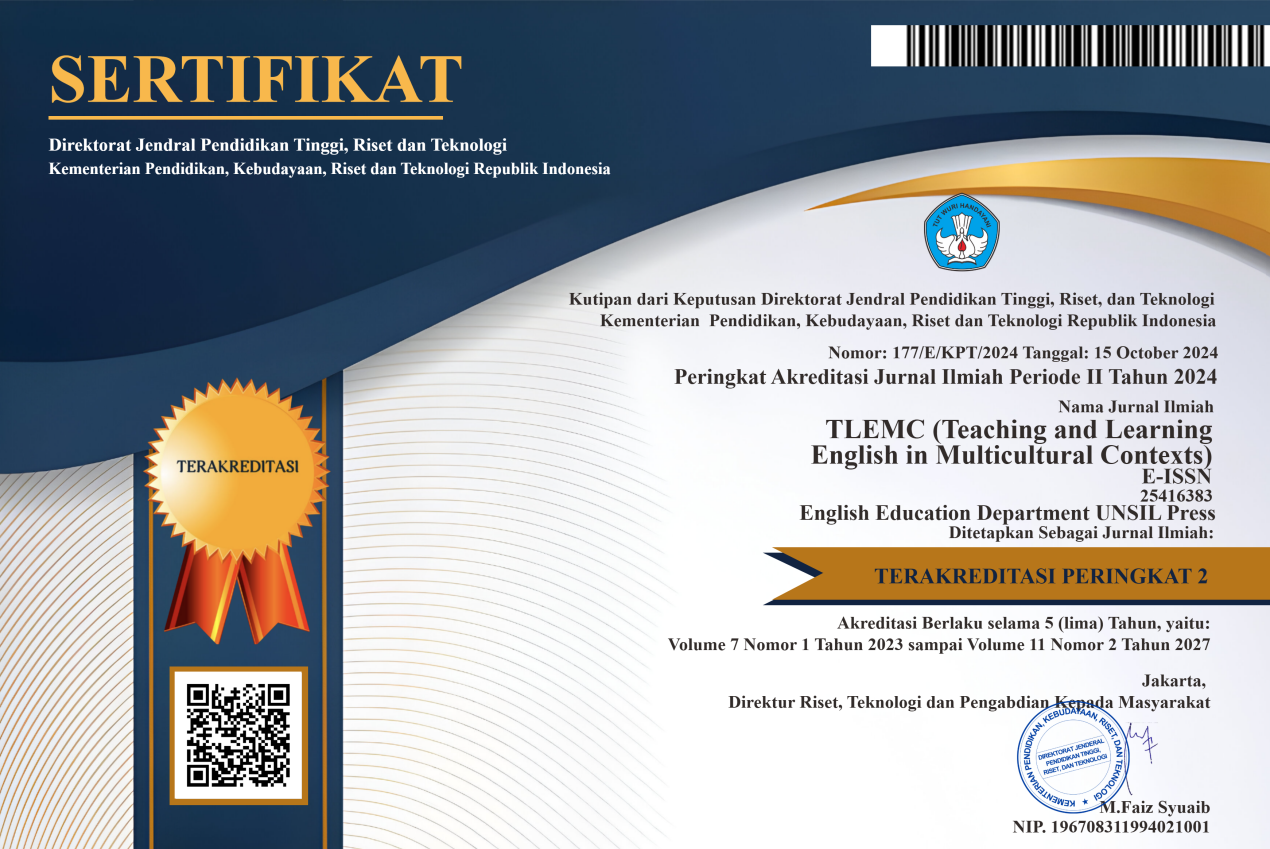"The Miracle Worker": A holistic approach to language acquisition pedagogy
Abstract
This study investigates the pedagogical potential of The Miracle Worker (1962) as a teaching medium in Language Acquisition courses, with a dual focus on linguistic development and character education. Employing a qualitative descriptive method with film content analysis, the research systematically examines key scenes and character interactions to identify how theoretical principles of language acquisition—such as behaviorist, nativist, interactionist, and affective approaches—are reflected in Helen Keller’s learning journey. Data were collected through close scene analysis, thematic coding, and interpretation aligned with major theories of language development. The findings reveal that the film presents a rich, multidimensional representation of the language acquisition process, highlighting the importance of tactile-based instruction, emotional support, and socially mediated interaction. Helen Keller’s journey illustrates that effective language learning is deeply influenced by both cognitive and affective factors. Traits such as perseverance, empathy, self-discipline, and emotional resilience are shown to facilitate communication and comprehension, suggesting a strong interdependence between character growth and linguistic development. The study concludes that The Miracle Worker is a powerful educational tool that can enhance students’ understanding of language acquisition concepts while also promoting reflective discussion on inclusive, empathetic teaching practices. By integrating academic content with character values, the film exemplifies a holistic approach to language education that addresses both intellectual and personal dimensions of learning.
Keywords: The Miracle Worker, language acquisition, character education, content analysis, holistic education
Full Text:
PDFReferences
Afnita, A., Saputra, D., Ulya, R. H., & Efrianto, E. (2021). Character education as a means of second language development in talented children: A study of sociolinguistic. AL-ISHLAH: Jurnal Pendidikan, 13(3), 1696–1704. https://doi.org/10.35445/alishlah.v13i3.996
Ahmed Abdel-Al Ibrahim, K., Cuba Carbajal, N., Zuta, M. E. C., & Bayat, S. (2023). Collaborative learning, scaffolding-based instruction, and self-assessment: impacts on intermediate EFL learners’ reading comprehension, motivation, and anxiety. Language Testing in Asia, 13(1). https://doi.org/10.1186/s40468-023-00229-1
Alharbi, J. M. (2023). Insight into the role of interaction in language acquisition: Vygotsky's interactionist theory of language. Arab World English Journal, 14(2).
Aminova, D. K., Bondarenko, N. G., Popov, K. I., Shebzukhova, T. A., & Vartumyan, A. A. (2021). Harmonious development of the personality of schoolchildren in modern education system. Revista on Line de Política e Gestão Educacional, 4040–4054. https://doi.org/10.22633/rpge.v25iesp.7.16162
Badjadi, N. E. I. (2020). Learner-centered english language teaching: Premises, practices, and prospects. IAFOR Journal of Education, 8(1), 7–27. https://doi.org/10.22492/ije.8.1.01
Basnet, B. (2022). Application of the positive reinforcement to enhance the learnability of EFL Learners. Journal of Durgalaxmi, 125–130. https://doi.org/10.3126/jdl.v1i1.57109
Brito, N. H. (2017). Influence of the home linguistic environment on early language development. Policy Insights from the Behavioral and Brain Sciences, 4(2), 155–162. https://doi.org/10.1177/2372732217720699
Brown, H. D. (2007). Principles of language learning and teaching (5th ed.). Pearson Longman.
Campbell, E. E., & Bergelson, E. (2022). Making sense of sensory language: Acquisition of sensory knowledge by individuals with congenital sensory impairments. Neuropsychologia, 174, 108320. https://doi.org/10.1016/j.neuropsychologia.2022.108320
Castro, E., & Shelton-Strong, S. J. (2024). Exploring emotions in language learning: Learners’ self-awareness, personal growth, and transformation on a CLIL course. Language Teaching Research. https://doi.org/10.1177/13621688241267366
Cheng, X., & Zhou, S. (2023). The influence mechanism of parental emotional companionship on children’s second language acquisition. Frontiers in Psychology, 13. https://doi.org/10.3389/fpsyg.2022.1034867
Chomsky, N. (1959). A Review of B.F. Skinner’s Verbal behavior. In Language (Vol. 35, Issue 1). https://doi.org/10.2307/411334
Coëgnarts, Maarten., & Kravanja, Peter. (2015). Embodied cognition and cinema. Leuven University Press.
Cruz, J. B. Dela, Escarlos, G., Mechelle, M., Remorosa, R., Capili, S. R., Grace, E., Decir, B., Delacruz, J. B., Mae, M., Balase, H., & Escarlos, G. S. (2024). Vygotsky’s social development theory: The role of social interaction and language in cognitive development. International Journal of All Research Writings, 6. www.ijarw.com
Dil, N. (1984). Nonverbal communication in young children. Topics in Early Childhood Special Education, 4(2), 82–99. https://doi.org/10.1177/027112148400400207
Embarek, R., & Hacene, B. (2024). The Role of Experiential Learning in Teaching Language Skills. Journal for Educators, Teachers and Trainers JETT, 15(3), 312–320. https://doi.org/10.47750/jett.2024.15.03.026
Ertanir, B., Kaiser‐Kratzmann, J., & Sachse, S. (2021). Long‐term interrelations between socio‐emotional and language competencies among preschool dual language learners in Germany. British Journal of Educational Psychology, 91(2), 735–754. https://doi.org/10.1111/bjep.12391
Evanson, L., Lakretz, Y., & King, J.-R. (2023). Language acquisition: do children and language models follow similar learning stages? http://arxiv.org/abs/2306.03586
Ferková, Š., & Zacharová, Z. (2023). Implementation of moral education by teachers of foreign languages. Journal of Language and Cultural Education, 11(3), 67–75. https://doi.org/10.2478/jolace-2023-0028
Fidelia, V. D., & Rohmah, Z. (2023). Using English Movies to improve students’ listening skills. NOBEL: Journal of Literature and Language Teaching, 14(2), 206–225. https://doi.org/10.15642/nobel.2023.14.2.206-225
Field, Syd. (2005). Screenplay: the foundations of screenwriting. Delta Trade Paperbacks.
Gambino, A., & Share, J. (2023). Critical media literacy and second language acquisition. In International Encyclopedia of Education (Fourth Edition) (pp. 76–85). Elsevier. https://doi.org/10.1016/B978-0-12-818630-5.07072-X
Halliday, M. A. K. (1985). Dimensions of discourse analysis: grammar. van Dijk (ed). Handbook of Discourse Analysis, 2, 29–56.
Hiver, P., & Solarte, A. C. S. (2021). Resilience in language learning and use. In The Routledge Handbook of the Psychology of Language Learning and Teaching (pp. 205–217). Routledge. https://doi.org/10.4324/9780429321498-19
Jeonbuk, Z. (2023). Enhancing English Writing Proficiency in China’s Polytechnic Students: An In-Depth Literature Review on the Application of the Input Hypothesis.
Karimaliana, K., Ramadhan, S., & Mukhaiyar, M. (2024). Transformative Literacy Training for English Students: The Impact of Movie-Based Learning Methods. VELES (Voices of English Language Education Society), 7(3), 829–838. https://doi.org/10.29408/veles.v7i3.24296
Khasanah, U. (2020). Character education values in the miracle worker movie. Unpublished Thesis. State Institute of Islamic Studies of Jember. Indonesia.
Korkmaz, Ş. Ç., & Karatepe, Ç. (2018). The Impact of Multi-sensory Language Teaching on Young English Learners’ Achievement in Reading Skills (Vol. 12, Issue 2).
Krashen, S. (1992). The input hypothesis: An update. Linguistics and language pedagogy: The state of the art, 409-431.
Laoli, A., Bago, E., Lase, D. A., Vita, H., & Gulo, S. (2025). Influence of Watching English Movies on English Language Speaking Skills. International Journal of Multilingual Education and Applied Linguistics, 2. https://doi.org/10.61132/ijmeal.v2i1.187
Lawton, W., Araujo, O., & Kufaishi, Y. (2023). Language Environment and Infants’ Brain Structure. The Journal of Neuroscience, 43(28), 5129–5131. https://doi.org/10.1523/JNEUROSCI.0787-23.2023
Li, Y. (2023). Study on the Significance of the Input Hypothesis to English Teaching. In Journal of Education and Educational Research (Vol. 3, Issue 2).
Loschky, L. (1994). Comprehensible input and second language acquisition. Studies in Second Language Acquisition, 16(3), 303–323. https://doi.org/10.1017/S0272263100013103
Lv, Z. (2023). The Significance of English Movies on Learning English in EFL Classrooms. The Educational Review, USA, 7(8), 1111–1115. https://doi.org/10.26855/er.2023.08.013
McKee, R. (1997). Robert McKee - Story. ReganBooks.
Mustoip, S., Al Ghozali, M. I., As, U. S., & Sanhaji, S. Y. (2023). Implementation of Character Education through Children’s Language Development in Elementary Schools. IJECA (International Journal of Education and Curriculum Application), 6(2), 91. https://doi.org/10.31764/ijeca.v6i2.14192
Nadeem, M. (2012). Learner-Centered English Language Teaching (An Observation: Public & Private Teachers’ Training Systems At Primary Level). In The International Journal of Engineering And Science. www.theijes.com
Naeem, F. (2022). Behaviorism and the Study of Language Acquisition and Language Learning Background. https://doi.org/10.13140/RG.2.2.35525.12003
Napitupulu, L. H., & Bako, E. N. (2024). Analysis of Language Acquisition in Children Aged 0-5 Years in the Care of Career Mother: Behaviorism Theory-B.F Skinner. ELT (English Language Teaching Prima Journal), 6(1), 1–21. https://doi.org/10.34012/elt.v6i1.5042
Novalina, S., Anwar, K., Maharani, R., Suryani, D., Sari, D., & Hariandi, R. (2024). Language Development and Building Character Early Children through Role Playing Method. Bulletin of Science Education, 4(1), 16-23. https://doi.org/https://doi.org/10.51278/bse.v4i1.820
Pauzan. (2024). Theory in second language acquisition (recognition of concepts toward Krashen’s second language acquisition theory for five main hypotheses). Journal on Education, 06(4), 20876–20888.
Peras, J., & Charity T. Turano. (2024). Implementation of comprehensible input in teaching English as a Second Language: Basis for an action plan. International Journal of English Language Studies, 6(3), 83-96. https://doi.org/10.32996/ijels.2024.6.3.11
Pervan, Ö. (2024). The role of films in English as a Foreign Language (EFL) teaching: An exploration of pedagogical contributions. International Journal of Advanced Natural Sciences and Engineering Researches, 11(11). https://as-proceeding.com/index.php/ijanser
Putri, Y. T., & Fitri, N. (2020). An analysis of educational values of the main character in “The Miracle Worker” movie. Journal Of English Language Teaching, 4(1).
Rahayu, W., Ro’is, S., & Munifah, S. (2021). Behaviorism theory in Miracle Worker movie. Salience Journal, 2(1).
Ramadhan, A. R., Zamruddin, M. P., & Tawakkal, A. (2023). The main character development in The King of Staten Island film. Ilmu Budaya: Jurnal Bahasa, Sastra, Seni, dan Budaya, 7(2).
Rankin, P. S., Staton, S., Potia, A. H., Houen, S., & Thorpe, K. (2022). Emotional quality of early education programs improves language learning: A within‐child across context design. Child Development, 93(6), 1680–1697. https://doi.org/10.1111/cdev.13811
Rifa A. A. (2022). Representasi Character Building dalam Film The Miracle Worker (Analisis Semiotika Charles Sanders Pierce). (Doctoral dissertation, UIN Prof. KH Saifuddin Zuhri Purwokerto)
Rintaningrum, R. (2009). Literacy: Its importance and changes in the concept and definition. Teflin, 20(1), 1-7.
Rowe, M. L., & Goldin‐Meadow, S. (2009). Early gesture selectively predicts later language learning. Developmental Science, 12(1), 182–187. https://doi.org/10.1111/j.1467-7687.2008.00764.x
Rowe, M. L., Özçalişkan, Ş., & Goldin-Meadow, S. (2008). Learning words by hand: Gesture’s role in predicting vocabulary development. First Language, 28(2), 182–199. https://doi.org/10.1177/0142723707088310
Rudy. (2022). American films as an educational tool for character development of teenagers. International Research Journal of Science, 2(1), 143. https://doi.org/10.5281/zenodo.6496839
Rudy, Nasution, J. & Rambe, K. R. (2020). Learning through watching films. ELT (English Language Teaching Prima Journal), 1(1). https://doi.org/10.34012/elt.v%vi%i.813
Sakkir, G., & M, Usman. (2018). Movie in enhancing students’ vocabulary. Eralingua: Jurnal Pendidikan Bahasa Asing Dan Sastra, 2(2). https://doi.org/10.26858/eralingua.v2i2.6757
Sari, T.K., & Hanifah Rahmani, P. (2024). The role of positive reinforcement on students in English language learning: a Skinnerian behaviorist. JOEY, 3(1), 1–5. https://doi.org/10.35316/JOEY.2022.vxix.x-xx
Sánchez-Auñón, E., Férez-Mora, P. A., & Monroy-Hernández, F. (2023). The use of films in the teaching of English as a foreign language: a systematic literature review. In Asian-Pacific Journal of Second and Foreign Language Education (Vol. 8, Issue 1). Springer Science and Business Media B.V. https://doi.org/10.1186/s40862-022-00183-0
Skinner B.F. (1957). Verbal behavior. Appleton-Century-Crofts.
Sulayani, N., Sitohang, L., Simbolon, L. O., & Tarigan, M. S. B. (2021). Moral value and character education found in movie Miracle in Cell no 7. EDUKATIF : Jurnal Ilmu Pendidikan, 4(1), 162–169. https://doi.org/10.31004/edukatif.v4i1.1753
Tamblyn, A., Sun, Y., May, T., Evangelou, M., Godsman, N., Blewitt, C., & Skouteris, H. (2023). How do physical or sensory early childhood education and care environment factors affect children’s social and emotional development? A systematic scoping review. In Educational Research Review (Vol. 41). Elsevier Ltd. https://doi.org/10.1016/j.edurev.2023.100555
Thao, L. T., Thuy, P. T., Thi, N. A., Yen, P. H., Thu, H. T. A., & Tra, N. H. (2023). Impacts of Emotional Intelligence on Second Language Acquisition: English-Major Students’ Perspectives. SAGE Open, 13(4). https://doi.org/10.1177/21582440231212065
Vygotsky, L. S. (1978). Mind in society: The development of higher psychological processes. Harvard University Press.
Wang, S., Wu, X., & Xiong, Z. (2021, June). The Effect of Teachers’ Reinforcement on English Learning Engagement of EAL learners. In 2021 2nd International Conference on Mental Health and Humanities Education (ICMHHE 2021) (pp. 495-502). Atlantis Press.
Yang, L., & Duan, M. (2023). The role of emotional intelligence in EFL learners’ academic literacy development. Heliyon, 9(1), e13110. https://doi.org/10.1016/j.heliyon.2023.e13110
DOI: https://doi.org/10.37058/tlemc.v8i2.14026
Refbacks
- There are currently no refbacks.
INDEXED BY:
This work is licensed under a Creative Commons Attribution-NonCommercial-ShareAlike 4.0 International License.
![]()
TLEMC (Teaching and Learning English in Multicultural Contexts)
Program Studi Pendidikan Bahasa Inggris
Fakultas Keguruan dan Ilmu Pendidikan
Universitas Siliwangi
Jl. Siliwangi No. 24 Kota Tasikmalaya - 46115
email: tlemc@unsil.ac.id





